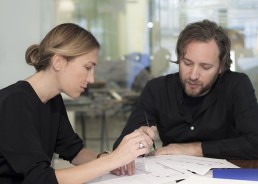
Seyhan Özdemir
Internationally renowned, Istanbul-based design studio Autoban works across architecture and interiors, product and design, forging a reputation for thoughtfulness, experimentation and craftsmanship.
darc talks to co-founder Seyhan Özdemir on the history of the studio and what the future holds.
With a portfolio ranging from transportation and commercial to retail and office developments, Autoban’s work is typified by familiar forms and materials repurposed in vital, contemporary ways.
Their work has redefined Istanbul’s cityscape, including numerous hospitality, retail, residential and public realm developments, and is now also found in London, Madrid, Hong Kong, Moscow and China, as well as Azerbaijan.
Founded in 2003 by friends Seyhan Özdemir and Sefer Çağlar, who met while studying at Mimar Sinan University, Seyhan studying architecture while Sefer studied interior design, after graduation Özdemir and Çağlar worked together and separately, for other architecture firms for five years before finally deciding to start their own design studio. “Our first office was in Galata, a historic neighbourhood with a genuine Istanbul vibe,” Özdemir tells darc. “This unique location enabled us to understand craftsmanship and local manufacturing techniques.
The biggest disadvantage we faced at the time was not having any industry support, but that eventually became an advantage for us because of the great craftsmanship these local workshops offered. We’ve managed to keep our designs handcrafted ever since and away from mass production, it has since become the calling card of Autoban.” Çağlar was born into a family of furniture designers so design felt like his natural course and was something he was passionate about from an early age, while for Özdemir the concept of beauty was something that intrigued her since childhood. “I think for both of us everything started with passion, the rest was the faith we showed each other, dedication and the hard work we put in.
A fascination with common and unusual materials has since become the studio’s trademark, skilfully and instinctively pushing them to their full potential. Forward looking and context-sensitive, human and spatial, micro and macro, Autoban embodies all of these traits and find their balance, creating unique spaces in the process. Çağlar’s and Özdemir’s obvious skillset in experiential design and keen interest in the transport business, has led them down some eclectic paths. In 2011 Autoban designed the Turkish Airlines CIP Lounge at Istanbul Ataturk Airport which won Skytrax World’s Best Business Class Lounge Awards. Then came the Heyder Aliyev International Airport in Baku Azerbaijan where they were held responsible for the interior design of the new terminal building that earned them a Red Dot Award. Recently they were tasked with the interior design of the Yacht Aquarius, a project that was honoured at the International Yacht & Aviation Awards 2017.
This year shows no sign of slowing down for the Autoban team with several diverse projects in the works worldwide.
“We have been commissioned to reinterpret the interiors of the first art deco hotel in Prague; a passenger terminal for cruise liner; and two resorts in the Maldives. We are currently working on the interiors of a 40ft motor yach and recently created the Wish Machine Installation, a design project we undertook as Turkey’s contribution to the latest Design Biennale, it was very inspiring, art is a great source of inspiration for us,” admits Özdemir. “We also find inspiration in the desires of the client, the environment in which the space resides or the history of the building. We approach projects as storytellers, we seek to create a design full of character set up around a story that fosters memorable experiences and imagination.”
For Çağlar and Özdemir lighting is a key element in bringing that story together, describing it as transformative, magical and evocative. “We use light to expand the boundaries, sometimes to emphasise the material behind an barchitectural feature, or to illuminate a detail to make it the focal point.” Özdemir explains. “It is different to any other form of design because it embraces functionality but it also involves a kind of magic. Light is invisible until it strikes an object or surface, when it is turned off it disappears.”



